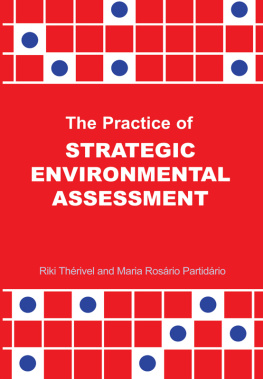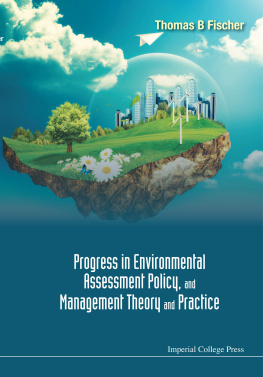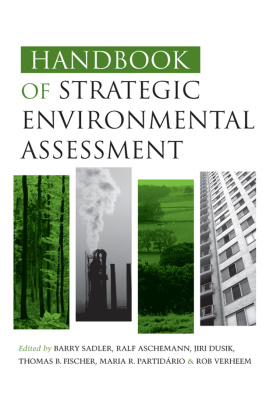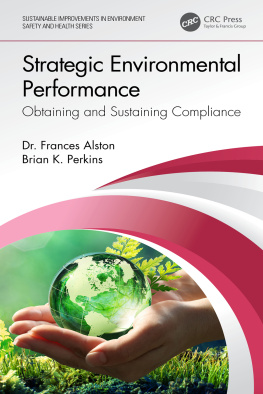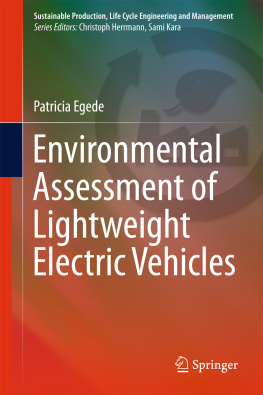The Practice of Strategic Environmental Assessment
First published in the UK in 1996 by
Earthscan Publications Limited
Copyright Riki Thrivel and Maria Rosrio Partidrio, 1996
Reprinted 1999, 2002
All rights reserved
A catalogue record for this book is available from the British Library
ISBN: 1 85383 373 8
Typesetting and page design by PCS Mapping & DTP, Newcasde upon Tyne
Cover design by Elaine Marriott
For a full list of publications please contact:
Earthscan
2 Park Square, Milton Park, Abingdon, Oxon 0X14 4RN
711 Third Avenue, New York, NY 10017
Earthscan is an imprint of the Taylor & Francis Group, an informa business
Earthscan publishes in association with WWF-UK and the International Institute for Environment and Development.
Contents
Riki Thrivel and Maria Rosrio Partidrio
Maria Rosrio Partidrio
Riki Thrivel
Volker Kleinschmidt and Dieter Wagner
J Warren Webb and Lorene L Sigal
Ann Dom
Rob Verheem
Ram Khadka, John McEachern, Olavi Rautianen, and Uttam S. Shrestha
John Rumble and Riki Thrivel
Eva Asplund and Tuija Hilding-Rydevik
Amy Skewes-Cox
Kevin Bradley
Ian Campbell
Maria Rosrio Partidrio and Riki Thrivel
Eva Asplund is a regional planner at the Regional Planning Division of the Royal Institute of Technology in Stockholm.
Dr Kevin Bradley is and environmental scientist, and works as an administrator with the European Commissions Environment, Nuclear Safety and Civil Protection Directorate-General (DG XI).
Ian Campbell is a senior environmental analyst at the Environment Bureau, Policy Branch, Agriculture and Agri-Food Canada.
Ann Dom is a physicist and an environmental consultant who has been involved in SEA for the transport sector for several years. She was project leader of the SEA for the European High Speed Train Network.
Dr Tuija Hilding-Rydevik is an assistant professor at the Division of Land and Water Resources in the Royal Institute of Technology in Stockholm.
Ram Khadka is the coordinator for the EIA Programme at IUCN-The World Conservation Union/Nepal in Kathmandu, Nepal.
Dr Volker Kleinschmidt is executive director of the environmental research consul-tancy Pro Terra Team, Division EIA Research Centre, based in Dortmund.
Dr Maria Rosario Partidario is an assistant professor at the Department of Sciences and Environmental Engineering at the New University of Lisbon, with a PhD on SEA (1992) from Aberdeen University. She is currently working on several SEA research projects.
John McEachern is a Country Representative of IUCN-The World Conservation Union/Nepal in Kathmandu, Nepal.
John Rumble is a town planner for Hertfordshire County Council. He is a mem-ber of the team that established the sustainability concepts for Hertfordshires structure plan.
Olavi Rautianen is chief forest officer at the Forest Management and Utilisation Development Project/FINNIDA in Kathmandu, Nepal.
Uttam S Shrestha is Programme Officer for the EIA Programme at IUCN-The World Conservation Union/Nepal in Kathmandu, Nepal.
Lorene L Sigal, retired, was until 1995 a research staff member and group leader in the Environmental Analysis Section of the Environmental Sciences Division at Oak Ridge National Laboratory. She led a number of projects that assess compliance with the US National Environmental Policy Act and other environmental regulations (eg, the Clean Air Act) and led a UN Task Force on applying the principles of EIA to policies, plans, and programmes.
Amy O Skewes-Cox is a land use planner and principal of her own consulting firm called Land/Water Consultants based in Berkeley and Markeleeville, California. The firm specialises in environmental impact analyses for land-use plans and new developments.
Riki Thrivel is a senior lecturer at Oxford Brookes Universitys School of Planning. She is joint course leader for the MSc course in Environmental Assessment and Management, and a research associate in the Impacts Assessment Unit.
Rob Verheem is currently Deputy secretary of the Dutch EIA Commission. He has worked at the European Commission in Brussels, and at the Ministry of the Environment.
Dieter Wagner is a city and regional planner in Kln.
J Warren Webb is a research staff member in the Environmental Analysis Section of the Environmental Sciences Division at Oak Ridge National Laboratory. In the area of SEA, he served on a UN Task Force on applying the principles of EIA to policies, plans and programmes and has helped prepare reports on hydropower policy and environmental analysis of trade agreements.
This book is the joint work of many individuals. Each case study chapter was written by (very busy) SEA practitioners to a very high standard and very tight deadlines. We are enormously grateful to all the contributors for their excellent and every editors dream prompt contribution. Jonathan Sinclair Wilson, our editor at Earthscan, gave us ongoing support, and ensured that the book was published as rapidly as possible. This collaborative effort has meant that the book is both practice-oriented and as up-to-date as possible.
The book has also indirectly benefitted from many other peoples input. The idea for the book arose during a conference on SEA organised by Janet Brand and Fiona Walsh at Crieff (Scotland) in March 1995. Stewart Thompson collaborated in a research project on SEA and nature conservation for English Nature, to which Brian Smith, Keith Porter and Paul Buckley gave invaluable advice; much of is based on that research. This and related research involved interviewing, running courses with, and receiving questionnaire responses from hundreds of SEA practitioners and local authority planners in the UK. Particular thanks to Martin Baxter, Chris Ferrary, Norman Lee, Arthur Keller, Peter Nelson, Karen Raymond, Bill Sheate and Nick Simon. Thanks also to John Glasson, Elizabeth Wilson, Joe Weston and the other wonderful members of Oxford Brookes Universitys Impacts Assessment Unit for a pleasant and supportive working environment.
Our acknowledgements must cut across continent frontiers. A research project on key issues in SEA, developed in Canada under NATO and the Canadian Environmental Assessment Agency, provided important insights on new approaches and existing realities; aspects of are based on that research. Discussions conducted as part of this research with various people, and particularly with Patrice LeBlanc, Ray Clark and Barry Sadler are gratefully acknowledged.





